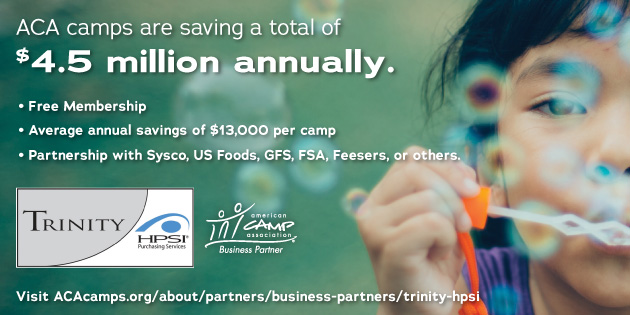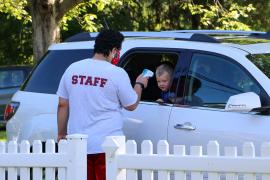Health screening, a practice typical to most camps' opening day process, has undergone an evolution. Granted, some changes were kick-started by our COVID-19 experience but, like other things, some changes are sticking because they have potential to improve the camp experience. In short, screening has expanded. It can and should start prior to arrival for campers and staff and extend beyond their end-of-session (agreement) date. Specifically, pre-arrival health monitoring has been added. That's supported by opening day's more common health screening and followed by intentional in-session surveillance. The screening process is completed with an assessment once the participants leave (return home).
These modifications impact parents, health center staff, as well as camp management policies and practices. Enhanced health screening also raises awareness among campers and staff about their own responsibility in health matters, contributing to youth development outcomes. Enhanced screening further supports continuity of care principles (more about that later). Importantly, however, enhanced health screening is most effective when tailored to complement the social determinants of your population's health profile. For example:
- A camper's age may influence whether the camper or a parent completes a pre-arrival health assessment tool.
- Dollars available to spend on meals will impact nutrition.
- Personal tensions and anxiety can affect ability to sleep and/or function appropriately.
Keep in mind that adopting any of the expanded screening process and implementation recommendations detailed here means shaping them to complement the social determinants of your campers and staff. Doing so supports the screening process; failing to do so undermines it.
Pre-Arrival Health Assessment
Camps that operated during summer 2020 often used a pre-arrival health assessment tool to determine individuals' risk threat. These tools typically — and appropriately — focused on information germane to COVID-19 exposure. What we discovered, however, was that getting campers and staff to focus on their health readiness for camp contributed to a healthier camp experience. Camps anecdotally reported decreased health center visits and that people maintained their health (resistance to illness) by eating better, staying hydrated, exercising to raise their heart rate, and getting enough sleep. With that kind of outcome, why not continue the practice? Accomplishing this means adapting COVID-19 tools to include health-promoting behaviors.
As camps anticipate summer 2021, implementing pre-arrival health monitoring can not only decrease the potential for COVID-19, but also the potential that campers or staff will arrive ill with other concerns. It may even increase their desire to remain healthy during the camp experience. Accomplishing this means developing a pre-arrival screening tool or modifying an existing one. Sample forms are posted on the Association of Camp Nursing's (ACN) website at campnurse.org/education-and-resources/covid-19-considerations-for-camp/. One need not be an ACN member to access these.
Will Camp Policies Require COVID-19 Immunization?
This important question impacts both campers and staff. And by the time camp opens, state-specific regulations may have a hand in the answer. This issue also touches your camp's general policy on immunizations. Consider your stance now and note the distinction between client (campers) and employee (staff) directives.
While current tools focus on COVID-19, the tools can be expanded to ask about health behaviors such as:
- Hours of sleep last night
- Assessment of one's nutrition (i.e., poor, good, excellent) that day
- Amount of time spent with raised heart rate
- If the person received a COVID-19 immunization
Design the form so it starts seven to 10 days prior to camp arrival and provide the name and contact information for an appropriate camp professional should questions arise. Instruct campers and staff to bring their completed forms on arrival day; consider emailing a reminder about that. Their completed pre-arrival assessment becomes part of their health record and provides a springboard to the camp's on-going health surveillance.
Camp professionals are reminded that ACA's online Healthy Camps Toolbox includes a downloadable PDF that complements the pre-arrival screening process. Titled "A Healthy Camp Begins and Ends at Home," it's intended for parents and is available at ACAcamps.org/resource-library/research/healthy-camp-toolbox. The goal of prescreening is to ensure that campers and staff arrive ready for their camp experience and willing to take some responsibility for their health status.
Arrival Day Screening
Camps have traditionally done a basic health screening upon each person's arrival. Certainly continue, but augment the screening by reviewing the individual's pre-arrival assessment form (see above). Also explain how to maintain health while at camp. Encourage early intervention with presenting symptoms of illness or injury, and explain how camp living differs from home so campers and staff are better prepared to adjust their personal health practices. This last suggestion might be best delivered to the entire group at an opportune time (such as following the first meal or when groups come together for the first time) rather than taking time to do so as each person arrives.
Surveillance during the Camp Experience
Once camp is underway, involve all camp staff — not just health center staff — in monitoring the health status of those under their care and taking action when something is amiss. Staff supervisors should do this for the staff they oversee. Such monitoring is broader than noting just physical symptoms; mental, emotional, and social health (MESH) status should also be noted. Specifically, look for behavior patterns that indicate the person isn't doing well, such as:
- Change in eating and sleeping habits
- Gradual withdrawal from activities that used to be engaging and/or fun
- Listlessness
- Increasing problematic behavior
- Generic complaints about health (stomachache, increased fatigue, etc.)
- Withdrawal from others, especially friends and other supporting people
- Becoming short-tempered
Direct staff to tactfully ask individuals about such behaviors to determine if they are, in fact, indicating a health deterioration. Feeling sad because one didn't get a letter that day or having a headache after working or playing during a hot, humid day are both reasonably anticipated human responses. But continued sadness day after day or a headache that doesn't improve with rest and fluids warrants more attention. Pay particular attention when campers or staff complain of gastrointestinal upset such as nausea, cramping, and/or diarrhea.
The goal is to constantly survey others and note changes that may indicate a health problem — and then act on that observation. Get the person to talk about what's going on and refer suspicious findings to the health center for deeper assessment. Such surveillance is critical to camp health because it focuses on catching problems early rather than waiting for a full-blown outbreak or for the emotional collapse of a given individual.
Some camps capture the staff surveillance effort by noting it in their performance appraisal process. They catch staff "doing it right." One camp gave the health center staff gift certificates for a treat at the camp store to pass along when a staff member — perhaps a camper too — noticed something and acted on that observation.
Assessment and Feedback When Campers/Staff Leave Camp
Outcome assessment is common following a camp experience; we want to know how things went and if the camp program accomplished its objective(s). Why not inquire about individuals' health too? It's a good question to add on parent feedback forms, but also include it on the forms completed by campers and staff. Individuals should return to their homes in, at minimum, the same state of health as when they arrived at camp — preferably even better. No one should be so depleted by their camp experience that they need time to recover their sleep reserves, nutritional status, and/or their MESH resilience. Ask about health indicators and capture those results. In addition, provide parents and staff with the name and contact information of a camp professional should a health concern surface upon returning home.
Remind parents and staff to share their camp health outcomes with their primary care professional(s). Known as "continuity of care" among health providers, one's health status in a given context has potential to color the individual's health in a different context (Garst, Erceg, Weinberg, & Faricy, in press). Camp health history forms are great at asking about home and school experiences that impact an individual's health but rarely does the camp community return that favor. We need to close the loop by sharing the health impacts of camp with the individual's at-home providers or instructing our clients and employees to do so.
The time isn't far off when individuals will "own" their electronic health records and give permission for appropriate camp representatives to both access and contribute to those electronic records. Such permission will probably have a start and end date, so get ready. This will certainly support continuity of care, but it poses challenges for camp record keeping systems. Start thinking about it now. Meanwhile, update your screening process to more adequately support the health of your campers, staff, and the camp experience itself.
Linda Ebner Erceg's (RN, MS, PHN) many years of year-round work as a camp professional, leadership in the Association of Camp Nursing, and participation in ACA initiatives contribute to her Camping Magazine content. She facilitates the Healthy Camps Committee, a collaboration between ACA and ACN, while also enjoying a robust speaking and consulting career from her Bemidji, Minnesota, home base. These activities help make her personal motto, "Healthier Camping for All," a growing reality. Contact Linda via email at [email protected].



